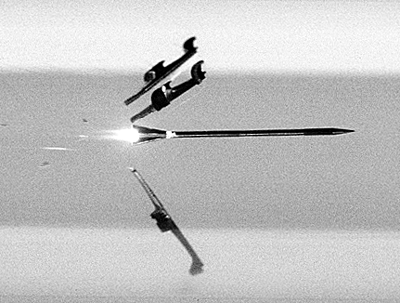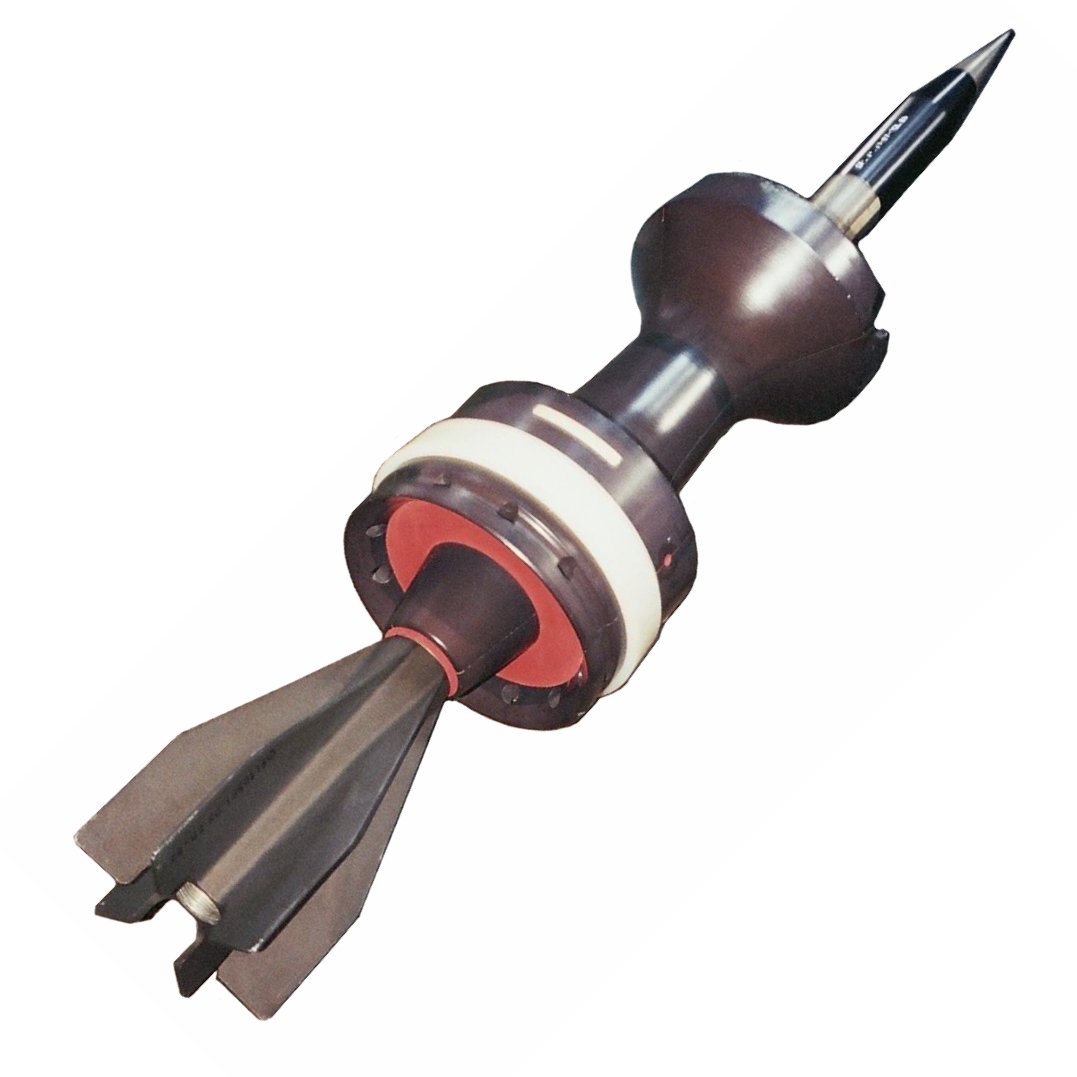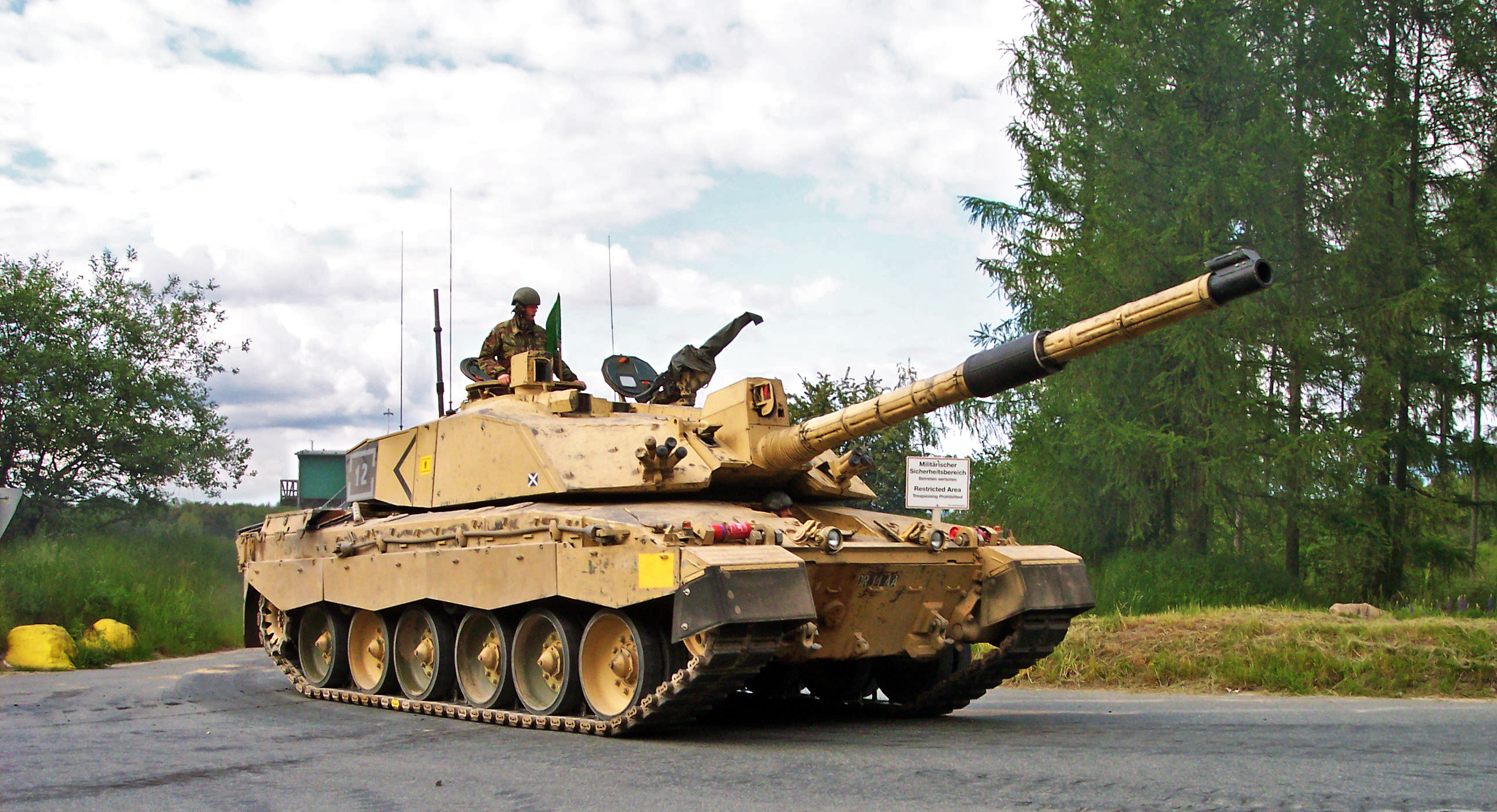|
APFSDS
Armour-piercing fin-stabilized discarding sabot (APFSDS), long dart penetrator, or simply dart ammunition, is a type of kinetic energy penetrator ammunition used to attack modern vehicle armour. As an armament for main battle tanks, it succeeds Armour-Piercing Discarding Sabot (APDS) ammunition, which is still used in small or medium caliber weapon systems. Improvements in powerful automotive propulsion and suspension systems following World War II allowed modern main battle tanks to incorporate progressively thicker and heavier armour protection systems, while maintaining considerable maneuverability and speed on the battlefield. As a result, achieving deep armour penetration with gun-fired ammunition required even longer anti-armour projectiles fired at even higher muzzle velocity than could be achieved with stubbier APDS projectiles. History Armour-piercing discarding sabot (APDS) was initially the main design of the kinetic energy (KE) penetrator. The logical progressio ... [...More Info...] [...Related Items...] OR: [Wikipedia] [Google] [Baidu] |
Royal Ordnance L30
The L30A1, officially designated Gun 120 mm Tk L30, is a 120 mm rifled tank gun used by the British Army and Royal Army of Oman. It is an improved production model of the Royal Ordnance L11 series of rifled tank guns. It is fitted in the turret of the Challenger 2 main battle tank, and has been retrofitted to the Challenger 1 tank. Challenger Armament The Challenger Armament (CHARM) project was intended to provide a new main armament for the Challenger 2 tank and to be retro-fitted to the Challenger 1. It involved three components: the gun, developed by the Royal Ordnance Factory, Nottingham, the depleted uranium (DU) APFSDS round, and a propellant charge for it. After earlier projects were cancelled, the EXP 32M1 experimental gun was re-titled the XL30E4 and accepted for production as the L30 in 1989. The Challenger 2 tank was first produced in 1993. Design The barrel is 55 calibres long (L55) and is made of electro-slag refined steel. The bore and chamber are e ... [...More Info...] [...Related Items...] OR: [Wikipedia] [Google] [Baidu] |
Sabot (firearms)
A sabot (, ) is a supportive device used in firearm/artillery ammunitions to fit/patch around a projectile, such as a bullet/shotgun slug, slug or a flechette-like projectile (such as a kinetic energy penetrator), and keep it aligned in the center of the barrel (firearms), barrel when fired. It allows a narrower projectile with high sectional density to be fired through a gun barrel, barrel of much larger caliber, bore diameter with maximal acceleration, accelerative transfer of kinetic energy. After leaving the muzzle (firearms), muzzle, the sabot typically separates from the projectile in flight, diverting only a very small portion of the overall kinetic energy. The sabot component in projectile design is the relatively thin, tough and deformable seal known as a driving band or obturation ring needed to trap propellant gases behind a projectile, and also keep the projectile centered in the barrel, when the outer shell of the projectile is only slightly smaller in diameter than t ... [...More Info...] [...Related Items...] OR: [Wikipedia] [Google] [Baidu] |
M829
The M829 is an American armor-piercing, fin-stabilized, discarding sabot (APFSDS) tank round. Modeling was designed at the Ballistic Research Laboratory (BRL) at Aberdeen Proving Ground (APG), which was incorporated into the Army Research Laboratory (ARL) in 1992. The round is specifically modeled for the 120 mm M256 main gun on the Abrams M1A1 and M1A2 main battle tanks. The penetrator is carried by a sabot during its acceleration in the gun barrel. Variants M829 The M829 has a ballistic nose and five tail fins made of aluminum. It is carried in the gun tube by a three-piece aluminum sabot, which separates into three "petals" soon after the round leaves the gun tube. The propulsion system uses an obturating case base with a semi-combustible cartridge wall. It has a total weight of and utilizes a DU penetrator with a rod diameter, which will reach a muzzle velocity of using of JA-2 propellant. Maximum effective range is . According to Jane's, the M829 is capable of pe ... [...More Info...] [...Related Items...] OR: [Wikipedia] [Google] [Baidu] |
M60 Tank
The M60 is an American second-generation main battle tank (MBT). It was officially standardized as the Tank, Combat, Full Tracked: 105-mm Gun, M60 in March 1959. Although developed from the M48 Patton, the M60 tank series was never officially christened as a Patton tank. The US Army considered it a "product-improved descendant" of the Patton tank's design. The design similarities are evident comparing the original version of the M60 and the M48A2. It has been sometimes informally grouped as a member of the Patton tank family. The United States fully committed to the MBT doctrine in 1963, when the Marine Corps retired the last ( M103) heavy tank battalion. The M60 tank series became America's primary main battle tank during the Cold War, reaching a production total of 15,000 M60s. Hull production ended in 1983, but 5,400 older models were converted to the M60A3 variant ending in 1990. The M60 reached operational capability upon fielding to US Army European units beginning in Dec ... [...More Info...] [...Related Items...] OR: [Wikipedia] [Google] [Baidu] |
Kinetic Energy Penetrator
A kinetic energy penetrator (KEP), also known as long-rod penetrator (LRP), is a type of ammunition designed to penetrate vehicle armour using a flechette-like, high-sectional density projectile. Like a bullet or kinetic energy weapon, this type of ammunition does not contain explosive payloads and uses purely kinetic energy to penetrate the target. Modern KEP munitions are typically of the armour-piercing fin-stabilized discarding sabot (APFSDS) type. History Early cannons fired kinetic energy ammunition, initially consisting of heavy balls of worked stone and later of dense metals. From the beginning, combining high muzzle energy with projectile weight and hardness have been the foremost factors in the design of such weapons. Similarly, the foremost purpose of such weapons has generally been to defeat protective shells of armored vehicles or other defensive structures, whether it is stone walls, sailship timbers, or modern tank armour. Kinetic energy ammunition, in its vari ... [...More Info...] [...Related Items...] OR: [Wikipedia] [Google] [Baidu] |
Royal Ordnance L7
The Royal Ordnance L7, officially designated Gun, 105 mm, Tank, L7, is the basic model of the United Kingdom's most successful tank gun. The L7 is a 105 mm L/52 rifled design by the Royal Ordnance Factories intended for use in armoured fighting vehicles, replacing the earlier QF 20-pounder (84 mm) tank gun mounted on the Centurion tank. The successful L7 gun has been fitted on many armoured vehicles including the British Centurion (starting from the Mk. 5/2 variant), the German Leopard 1 and several variants of the US MBTs M48 Patton and M60 in an altered design, the M68. The L7 is a popular weapon and continued in use even after it was superseded by the L11 series 120 mm rifled tank gun, for some Centurion tanks operating as Artillery Forward Observation and Armoured Vehicle, Royal Engineers (AVRE) vehicles. The L7, and adaptations of it, can be found as standard or retrofitted equipment on a wide variety of tanks developed during the Cold War. History Both the U ... [...More Info...] [...Related Items...] OR: [Wikipedia] [Google] [Baidu] |
Challenger 2
The FV4034 Challenger 2 (MOD designation "CR2") is a third generation British main battle tank (MBT) in service with the armies of the United Kingdom and Oman. It was designed and built by the British company Vickers Defence Systems (now known as BAE Systems Land & Armaments). Vickers Defence Systems began to develop a successor to the Challenger 1 as a private venture in 1986. The Ministry of Defence ordered a prototype in December 1988. In June 1991, the MoD placed an order for 140 vehicles, with a further 268 ordered in 1994. Production began in 1993 and the unit's tanks were delivered in July 1994, replacing the Challenger 1. After a production delay, the tank entered service with the British Army in 1998, with the last delivered in 2002. The Challenger 2 was also exported to Oman. The Challenger 2 is an extensive redesign of the Challenger 1. Although the hull and automotive components seem similar, they are of a newer design than for the Challenger 1 and only around 3% of ... [...More Info...] [...Related Items...] OR: [Wikipedia] [Google] [Baidu] |
Armour-piercing Discarding Sabot
Armour-piercing discarding sabot (APDS) is a type of spin-stabilized kinetic energy projectile for anti-armour warfare. Each projectile consists of a sub-calibre round fitted with a sabot. The combination of a lighter sub-calibre projectile with a full-calibre propellant charge allows for an increase in muzzle velocity compared to full-calibre rounds, giving the round increased armour-penetration performance. To further enhance their armour-penetration capabilities, APDS rounds typically feature a hardened core made from tungsten or another hard, dense material. For a given calibre, APDS ammunition can effectively double the armour penetration of a gun when compared to full-calibre rounds such as AP, Armour-piercing Capped (APC), and Armour piercing Capped Ballistic Cap (APCBC) projectiles. APDS-rounds were commonly used in large calibre tank guns up until the early 1980s, but have since been superseded by armour-piercing fin-stabilized discarding sabot (APFSDS) projectiles, ... [...More Info...] [...Related Items...] OR: [Wikipedia] [Google] [Baidu] |
Armour-piercing Discarding Sabot
Armour-piercing discarding sabot (APDS) is a type of spin-stabilized kinetic energy projectile for anti-armour warfare. Each projectile consists of a sub-calibre round fitted with a sabot. The combination of a lighter sub-calibre projectile with a full-calibre propellant charge allows for an increase in muzzle velocity compared to full-calibre rounds, giving the round increased armour-penetration performance. To further enhance their armour-penetration capabilities, APDS rounds typically feature a hardened core made from tungsten or another hard, dense material. For a given calibre, APDS ammunition can effectively double the armour penetration of a gun when compared to full-calibre rounds such as AP, Armour-piercing Capped (APC), and Armour piercing Capped Ballistic Cap (APCBC) projectiles. APDS-rounds were commonly used in large calibre tank guns up until the early 1980s, but have since been superseded by armour-piercing fin-stabilized discarding sabot (APFSDS) projectiles, ... [...More Info...] [...Related Items...] OR: [Wikipedia] [Google] [Baidu] |
Tank
A tank is an armoured fighting vehicle intended as a primary offensive weapon in front-line ground combat. Tank designs are a balance of heavy firepower, strong armour, and good battlefield mobility provided by tracks and a powerful engine; usually their main armament is mounted in a turret. They are a mainstay of modern 20th and 21st century ground forces and a key part of combined arms combat. Modern tanks are versatile mobile land weapons platforms whose main armament is a large-caliber tank gun mounted in a rotating gun turret, supplemented by machine guns or other ranged weapons such as anti-tank guided missiles or rocket launchers. They have heavy vehicle armour which provides protection for the crew, the vehicle's munition storage, fuel tank and propulsion systems. The use of tracks rather than wheels provides improved operational mobility which allows the tank to overcome rugged terrain and adverse conditions such as mud and ice/snow better than wheeled vehicles, ... [...More Info...] [...Related Items...] OR: [Wikipedia] [Google] [Baidu] |
Main Battle Tank
A main battle tank (MBT), also known as a battle tank or universal tank, is a tank that fills the role of armor-protected direct fire and maneuver in many modern armies. Cold War-era development of more powerful engines, better suspension systems and lighter-weight composite armor allowed the design of a tank that had the firepower of a super-heavy tank, the armor protection of a heavy tank, and the mobility of a light tank, in a package with the weight of a medium tank. Through the 1960s and 1970s, the MBT replaced almost all other types of tanks, leaving only some specialist roles to be filled by lighter designs or other types of armored fighting vehicles. Main battle tanks are a key component of modern armies.#House1984, House (1984), ''Toward Combined Arms Warfare: A Survey of 20th-Century Tactics, Doctrine, and Organization'' Modern MBTs seldom operate alone, as they are organized into armoured units that include the support of infantry, who may accompany the tanks in inf ... [...More Info...] [...Related Items...] OR: [Wikipedia] [Google] [Baidu] |
General Dynamics
General Dynamics Corporation (GD) is an American publicly traded, aerospace and defense corporation headquartered in Reston, Virginia. As of 2020, it was the fifth-largest defense contractor in the world by arms sales, and 5th largest in the United States by total sales. The company is a Fortune 100 company, and was ranked No. 94 in 2022. Formed in 1954 with the merger of submarine manufacturer Electric Boat and aircraft manufacturer Canadair, the corporation today consists of ten subsidiary companies with operations in 45 countries. The company's products include Gulfstream business jets, Virginia- and Columbia-class nuclear-powered submarines, Arleigh Burke-class guided-missile destroyers, M1 Abrams tanks and Stryker armored fighting vehicles. In 2021, General Dynamics had worldwide sales of $38.85 billion and a workforce of approximately 103,000 full-time employees. The current chairman and chief executive officer (CEO) is Phebe Novakovic. History Electric Boat Ge ... [...More Info...] [...Related Items...] OR: [Wikipedia] [Google] [Baidu] |










